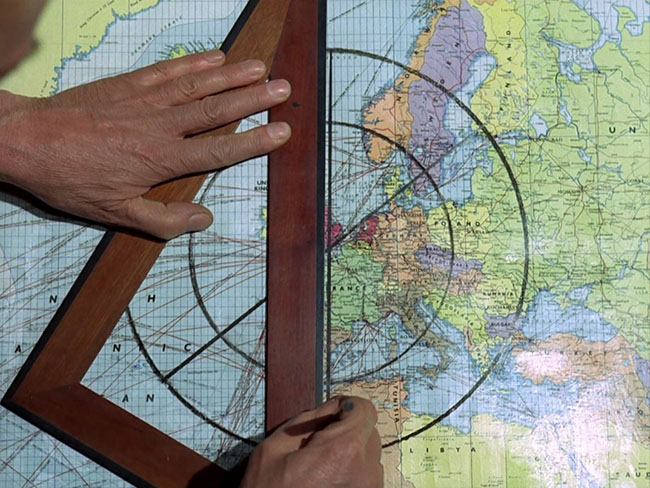
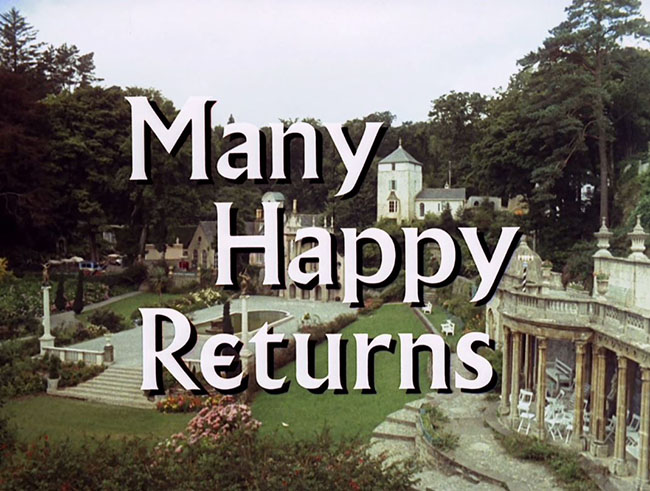 MANY HAPPY RETURNS First UK Broadcast: November 10, 1967 [episode #7 in transmission order] | Written by Anthony Skene | Directed by Joseph Serf (Patrick McGoohan)
MANY HAPPY RETURNS First UK Broadcast: November 10, 1967 [episode #7 in transmission order] | Written by Anthony Skene | Directed by Joseph Serf (Patrick McGoohan)
SYNOPSIS
No.6 awakens one morning to find the Village shut down and completely deserted. After an investigation turns up no signs of life, he makes preparations for a journey by sea. He gathers supplies, cuts down trees to build a raft, and finally takes pictures of the Village using a camera and film from the general store. Just as he is about to shove off, he hears a noise behind him; turning around with dread, he sees only the stray black cat (from “Dance of the Dead“) watching. On the water, he protects his photographs by sealing the roll of film in a plastic bag, and makes a compass by magnetizing a needle. After eighteen days at sea, he’s discovered by smugglers, who push his unconscious body into the water and steal the goods he’s brought from the Village. No.6 recovers, boards the ship in secret, and battles the smugglers. He’s forced to abandon the ship and swims for a nearby lighthouse. From there, he meets and eats with some welcoming Romani travelers, and in the morning discovers an English highway. He sneaks into the back of a passing truck and rides it into London. When he finally gets back to his home (No.1 Buckingham Place, London, SW1), it is occupied by a woman named Mrs. Butterworth (Georgina Cookson), who also now owns No.6’s car, the Lotus Seven that he built himself. She invites him in and offers him a meal, which he devours, while she offers evidence that she purchased his flat fair and square, and the car came along with it. He tells her his name is Peter Smith. He learns that it’s March 18; his birthday is tomorrow. She returns his car to him and he drives back to his London office (recreating the opening credits). He meets with his colleagues “the Colonel,” real name James (Donald Sinden, The Day of the Jackal), and Thorpe (Patrick Cargill, Help!), and describes to them the Village, offering the photos as evidence. Although they’re skeptical at first, they’re able to confirm certain facts about his journey and proceed to work out just where the Village might be. It’s concluded that it must be on the coast of Morocco, southwest of Portugal and Spain. No.6 does reconnaissance on a jet and indeed locates the Village, but as he’s flying overhead, his co-pilot says “Be seeing you!” and ejects him. No.6 lands in a parachute, and the Village begins to come to life again. No.2, accompanied by the black cat, greets him in his residence – it is Mrs. Butterworth, and she presents him with a birthday cake and says, “Many happy returns.” He looks out the window: the Village is now filled with its familiar residents.
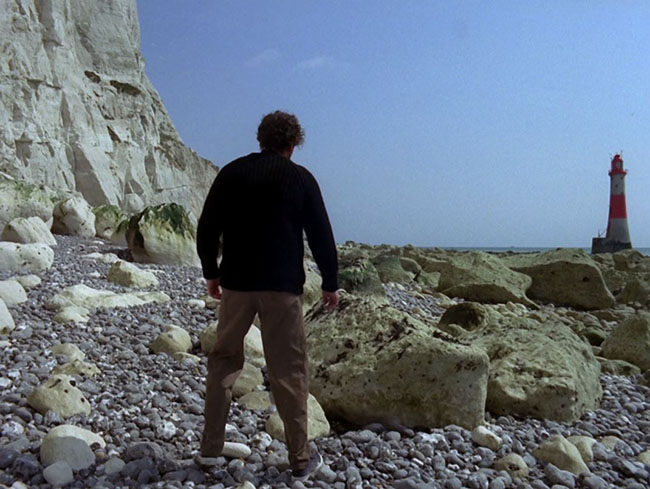
No.6 and the lighthouse.
OBSERVATIONS
“Many Happy Returns” is an episode of revelations, and gripping for regular viewers, who are finally able to see No.6 successfully escape the Village. But where did the Villagers go, and why was the prison seemingly decommissioned? Much of the tension comes from the friction between the Prisoner’s seeming freedom and the viewer wondering when the shoe will drop; the show’s premise, after all, is that he will remain a prisoner by each episode’s end. Writer Anthony Skene, who also scripted the nightmarish “Dance of the Dead,” shifts with ease into a much more realistic survivalist drama. Patrick McGoohan directs under a pseudonym, and it is very strong work, holding the viewer’s attention although not a word of dialogue is spoken until 23 minutes in – almost halfway through the episode. The original script had No.6 speaking a bit earlier, exchanging words with the smugglers and taunting them with “Be seeing you” before jumping into the sea. Wisely, these lines were removed to pursue a goal of pure cinema, and to add that much impact when he does finally speak. (“Where is this?” he asks one of the Romani people.) Skene draws some connections between this episode and his earlier “Dance of the Dead,” namely with the presence of the black cat, which drops a clue that this will feature another female No.2. (In that episode, No.6 is told that the cat works for Mary Morris’s No.2, and he responds, “Never trust a woman. Even the four-legged variety.”) Therefore it is possible to guess the nature of the unfortunately named “Mrs. Butterworth.” Also suspicious is the fact that the opening credits do not show No.2’s face and use a “generic” voice (Robert Rietty). Take a look at Georgina Cookson’s expression when she sees No.6 standing on the doorstep – she looks him over with an almost sadistic pleasure, because of course, with all the freedom in the world, he’s turned up exactly as she expected him to.
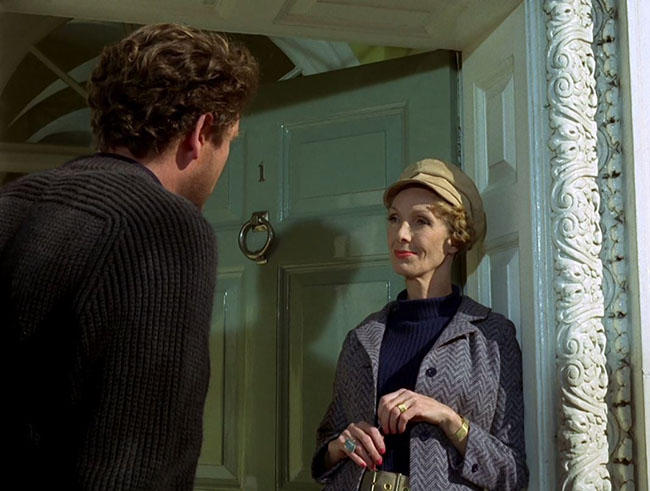
Georgina Cookson as Mrs. Butterworth.
The location of the Village is “definitively” given as being on or off the coast of Morocco. I put that word in quotes because (mild spoilers) this information is happily contradicted by “Fall Out.” But in this more realistic episode, he physically travels from the Village to London and vice versa, so it’s expected at this point in the series that the question of the Village’s location has been put to rest. The great irony Skene exploits is that knowing this information doesn’t help the Prisoner. Before he knows what’s happened, he’s back in the Village as securely held as ever. The episode has echoes of “The Chimes of Big Ben.” In the final act he is once more standing in the offices of (different) colleagues explaining the Village and confronting their skepticism. One of them is even called the Colonel (James), like COBB’s “Colonel J,” though they are different actors and must be different characters. If one or both of these two work for the Village, this could be another trick to discover why he resigned, though the matter isn’t pressed. (Given the fact that Patrick Cargill later plays No.2 in “Hammer Into Anvil,” a fan theory has it that he’s the same character here, a Village plant.) As with earlier episodes of the series, the goal seems to be to break No.6’s will and resolve him to the fact that he can never escape. At least in its final form this is the case, though in the original script No.2 does ask him why he resigned right after presenting his birthday cake. Skene also draws another connection to his “Dance of the Dead” with a deleted line: “Give in and enjoy being dead.” 6 responds, “I’ll die first.” We can be certain that the presence of the black cat makes this a sequel to that episode.
McGoohan is deserving of some more praise for his performance in this outing, carrying so much of the episode without any dialogue. In particular look at the scene when he’s about to set out on his raft and he hears something crash behind him. The way he freezes up and turns very slowly, and lifts his eyes – it is the look of a man whose hopes have been crushed by his captors many times before. Brilliant work all the way through.
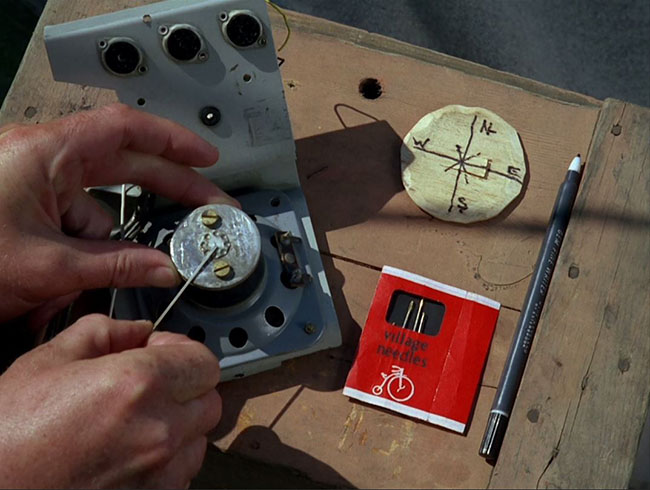
Building a compass.
6 OF 1…
The significance of the number of No.6’s flat should raise some early suspicions in the viewer.
SEQUENCE
This episode must come after both “Dance of the Dead” and “The Chimes of Big Ben” for the reasons given above. In particular, the plot of COBB loses all impact if viewed after this one. If No.6 already knows the Village is in Morocco, why would he listen to Nadia when she says it’s in the Baltic? (There is the possibility, of course, that there are multiple Villages and No.6 is moved between them, but he has no reason to believe that.) Similarly, “Many Happy Returns” benefits from the viewer’s knowledge that this time his journey to London is “really happening,” because he’s making his way there on his own, without being packaged in a crate.
No.6 meets Mrs. Butterworth on March 18, and his journey has taken almost a month. Therefore this should be the immediate episode to follow “The Schizoid Man,” which takes place in February and will bump up right against the events here.
THE OUTSIDE WORLD
Here we get our first good look at the world outside the Village, and that world is a very specific one to this series. The red-striped lighthouse is Beachy Head Lighthouse in East Sussex, a location which will appear even more prominently in “The Girl Who Was Death.” No.6’s flat is in Buckingham Place, and is part of the imagery featured in the opening credits of (almost) every episode. When he is behind the wheel of his Lotus Seven again, the episode suddenly becomes a variation of the episode opening, like entering a time loop, and recycles some of the same footage. He opens the door once more on script editor George Markstein, who now gets a close-up (though no dialogue).
No.6 provides his name as “Peter Smith” to Mrs. Butterworth, and it’s left to the viewer to decide if this is his real name or an alias. Given McGoohan’s hesitant delivery, it seems to me that he is making it up on the spot.
It’s worth pointing out that the Romani girl is played by Nike Arrighi, the strikingly beautiful actress from The Devil Rides Out (1968). It’s a shame she didn’t get a bigger role in this series, as she did in the Hammer film for which she’s still best known.
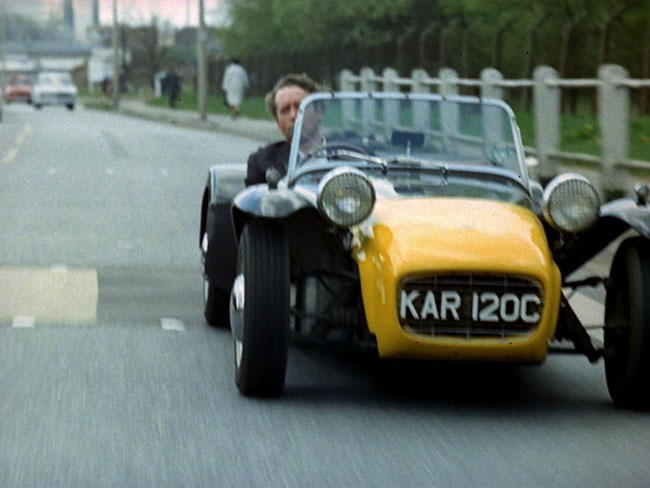
No.6 in his Lotus 7.
KAR 120C
We learn that the car which No.6 drives straight at the viewer in the opening credits is one that he built himself from a kit: a yellow S2 Lotus Seven, license plate KAR 120C. The British manufacturer produced the Lotus Seven, designed by its founder, between 1957 and 1972. We can see McGoohan behind the wheel here, although reportedly in the opening credits it is Lotus’s Chief Engineer who is driving the car up to Buckingham Place. In the famous close-up of McGoohan that opens The Prisoner, when he’s racing underneath a stormy sky, his hair is barely ruffled by the wind. This doesn’t reflect my experience in convertibles.
METHODOLOGY
This is one of the Village’s most counter-intuitive plots, giving No.6 total freedom, like a holiday, just to show just how easily they can bring him back. It is unclear to where the Villagers have vacated, but given their sudden reappearance at the end of the episode, surrealism is back in play. Apart from Mrs. Butterworth and the man who impersonates the jet pilot, it isn’t specified who else is in on this plot. (As I said, it’s possible that Cargill’s Thorpe is employed by the Village, since the actor later plays No.2, but he is not the only actor to be recycled into different roles in this series, a practice which continues in modern TV.)
FISTICUFFS
An elaborate fight with smugglers adds some necessary action to the Prisoner’s long journey home.
WIN OR LOSE?
Since No.6 can’t be credited for escaping the Village – that was handed to him – this is another demoralizing loss, particularly frustrating given how close he came to escaping. In “Arrival,” No.6 tells No.2 that he will escape the Village, come back, and “wipe it off the face of the Earth.” It’s the attempt to enact that plan which proves his undoing.
QUOTES
No.6: I also have a problem . . . I’m not sure which side runs this Village.
Mrs. Butterworth: Many happy returns.
UP NEXT: THE GENERAL
